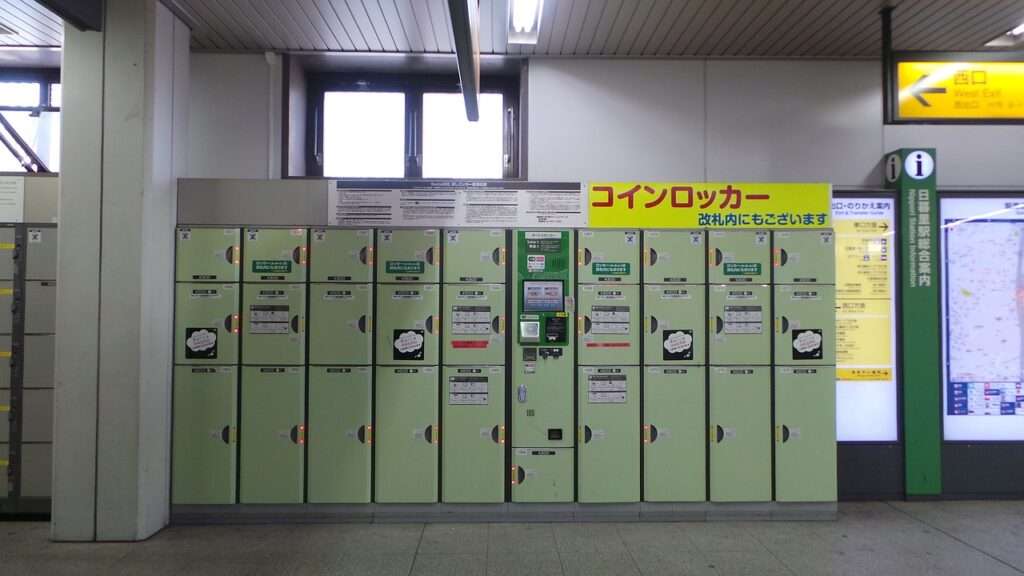Picture this: You’ve just landed at Narita Airport, excited to explore the neon-lit streets of Tokyo, but your check-in isn’t until 3 PM. Or maybe you’re checking out of your Kyoto hotel but don’t fly out until the evening. What do you do with your luggage? Trust me, I’ve been there! After living in Japan for several years and helping countless friends navigate this exact situation, I’ve become somewhat of an expert on Japan’s incredible luggage storage systems.
Here’s an eye-opening fact: With over 32 million international visitors expected in Japan in 2024, luggage storage has become more crucial than ever. The good news? Japan has one of the most efficient and secure luggage storage systems I’ve ever encountered in my travels. From automated coin lockers to hotel services and specialized delivery options, you’ll never have to drag your suitcase through a crowded temple again!
Let me be honest – my first time dealing with luggage storage in Japan was a bit overwhelming. All those coin lockers with their Japanese instructions, the different sizes, the payment systems… but don’t worry! I’ve made all the mistakes so you don’t have to. In this guide, I’ll walk you through everything you need to know about storing your luggage in Japan, from the cheapest options to the most convenient solutions.
Whether you’re planning a whirlwind tour of Tokyo, a peaceful exploration of Kyoto’s temples, or an extended journey across the country, proper luggage storage can make or break your travel experience. I’ll cover every option available – from train station lockers to hotel services, and even some lesser-known alternatives that most tourists never discover.
Understanding Japan’s Luggage Storage System
You know what amazed me when I first moved to Japan? The sheer organization of everything – and their luggage storage system is no exception! I remember standing in Tokyo Station, completely blown away by the rows upon rows of pristine lockers. It was like something out of a sci-fi movie, but way more practical!
Let me tell you, Japan’s approach to luggage storage isn’t just about having a place to stash your bags – it’s an entire infrastructure designed to make your life easier. I’ve used similar systems in countries across Asia and Europe, but nothing quite compares to the efficiency you’ll find here.
Before we dive into the nitty-gritty details, let me share a quick story. During my first week in Japan, I made the rookie mistake of trying to find a locker in Shibuya Station at 6 PM on a Friday. Big mistake! What I didn’t know then (but you will, thanks to this guide) is that timing is everything when it comes to luggage storage in Japan.
The basic storage options here fall into three main categories. First, you’ve got your coin lockers (or ‘コインロッカー’ – ‘koin rokkā’ in Japanese). These are everywhere, and I mean everywhere! Then there’s hotel storage, which is often free if you’re a guest. Finally, there’s the amazing takuhaibin service, which I like to call the “magic luggage teleportation system” – but more on that later!
Speaking of costs, let me break it down for you. Small coin lockers typically run around ¥300-¥400 per day, medium ones are ¥500-¥600, and large lockers can cost ¥800-¥1000. Pro tip: these prices can vary slightly by location, but they’re generally consistent across major cities. I’ve probably spent enough on coin lockers over the years to buy a small suitcase!
| Locker Size | Daily Cost (¥) |
|---|---|
| Small | 300-400 |
| Medium | 500-600 |
| Large | 800-1000 |
One thing that really sets Japan apart is the security of their storage options. In all my years here, I’ve never heard of anyone having their belongings stolen from a station locker. The Japanese take security seriously – most lockers have surveillance cameras nearby, and in stations, there’s always staff around.
Train Station Coin Lockers: The Most Popular Option
Let me tell you about my first encounter with Japanese coin lockers – it was at Shinjuku Station, and I stood there for a good 15 minutes just trying to figure out which button to press! Now I can practically use them with my eyes closed. These lockers are absolutely everywhere in train stations, and they’re going to be your best friend during your Japan adventures.
Here’s something I wish someone had told me early on – not all coin lockers are created equal! The stations have different sizes, and picking the right one can save you both money and headaches. Small lockers are perfect for backpacks and can fit a carry-on suitcase if you’re strategic about it. Medium lockers can handle a standard suitcase, while the large ones can swallow up pretty much anything short of a body (okay, maybe that was a weird comparison, but you get the idea!).
Speaking of sizes, let me give you some exact measurements because this is something I get asked about all the time:
| Locker Size | Dimensions (cm) | Daily Cost (¥) |
|---|---|---|
| Small | 35 x 43 x 60 | 300-400 |
| Medium | 40 x 50 x 75 | 500-600 |
| Large | 45 x 60 x 90 | 800-1000 |
The payment system has gotten so much more convenient since I first arrived in Japan. While you can still use coins (make sure you have plenty of ¥100 coins!), most lockers now accept IC cards like Pasmo and Suica, and many even take credit cards. I cannot tell you how many times this has saved me when I’m running low on cash!
Now, let me share a pro tip that took me way too long to figure out – the best locations for lockers aren’t always obvious. In major stations like Tokyo, Shibuya, and Shinjuku, you’ll find lockers near multiple exits, but the ones nearest to the main gates are usually full. Instead, head to the less obvious locations within the station. For example, at Tokyo Station, there’s a fantastic set of lockers in the basement near the Yaesu exit that tourists often miss.
Peak travel seasons can be tricky – I learned this the hard way during cherry blossom season when I spent an hour trying to find an available locker! If you’re traveling during popular times (late March to early April, Golden Week in early May, or during the fall foliage season), here’s what I recommend: arrive early (before 9 AM) to secure a locker, or have a backup plan ready.
What happens if all the lockers are full? Don’t panic! I’ve been there, and there are always alternatives. Most major stations have staffed luggage storage counters (called “hand luggage” or 手荷物預かり所) that can hold your bags. Yes, they’re a bit more expensive than coin lockers, but they’ve saved me more than once when I was in a pinch.
One mistake I see many travelers make is assuming they can leave their luggage overnight. While technically possible in most lockers, it’s not recommended. The fees stack up (you’ll be charged for each calendar day), and some stations actually clear out lockers at closing time. Trust me on this one – I once had to make a mad dash to retrieve my bag before the station closed!
Hotel Luggage Storage Services
Can I share something that blew my mind when I first started traveling in Japan? Hotels here are incredibly accommodating when it comes to luggage storage! I remember being amazed when my hotel in Osaka not only stored my bags for free after check-out but actually tagged them with proper tracking numbers. Talk about Japanese efficiency!
Let me walk you through how hotel luggage storage typically works in Japan, because it’s a bit different from what you might be used to. Most hotels will gladly store your luggage both before check-in and after check-out. I’ve used this service countless times, and it’s become my go-to solution for those awkward timing situations between accommodations.
The best part? It’s usually completely free if you’re a guest! This was such a relief when I realized I could save those precious yen for more important things (like trying every flavor of Kit Kat in existence). Most hotels will store your bags from early morning until late evening, giving you the freedom to explore without lugging around your suitcase.
Here’s what the typical process looks like:
- Head to the front desk and let them know you’d like to store your luggage
- They’ll tag your bags with numbered tickets
- Keep your claim ticket safe (seriously, don’t lose it – I learned that lesson the hard way!)
- When you return, just show your ticket and collect your bags
One thing that really impresses me about Japanese hotels is their attention to security. Your bags aren’t just tossed in a corner – they’re usually stored in a dedicated storage room with staff supervision. I’ve even stayed at hotels where they use security cameras to monitor the storage area 24/7!
Now, let’s talk about some differences between hotels and hostels because this can trip up first-time visitors. While fancy hotels often have dedicated storage rooms, hostels might have more basic solutions like locked closets or supervised storage areas. But here’s the thing – I’ve found that hostels can actually be more flexible with storage times, especially if you build a good rapport with the staff.
Luggage Forwarding Services (Takuhaibin)
Let me introduce you to what I consider Japan’s best-kept travel secret: takuhaibin! I still remember the first time I used this service – I was skeptical about sending my suitcase ahead to Kyoto while I spent a day in Tokyo. But when I arrived at my hotel, there was my bag, perfectly intact, waiting for me. It felt like magic!
Takuhaibin (宅配便), or luggage delivery service, is something that makes traveling in Japan feel like you’re living in the future. The two main companies you’ll encounter are Yamato Transport (you’ll recognize their logo with the black cat) and Sagawa Express. I primarily use Yamato because they have English-speaking staff at major locations, which saved me numerous times when I was first figuring out the system.
Let me break down the costs because this is what usually surprises people – in a good way! Sending a standard-sized suitcase from Tokyo to Kyoto typically costs around ¥2,000-2,500. Yes, that’s more expensive than a coin locker, but think about it: you get door-to-door delivery and a full day of hands-free traveling. I’d say that’s worth every yen!
Here’s my step-by-step guide to using takuhaibin (trust me, I wish someone had explained this to me my first time):
- Go to your hotel’s front desk or a convenience store (konbini)
- Ask for takuhaibin service (or just point to your luggage and say “Yamato”)
- Fill out the form (most places have English forms available)
- Choose next-day or same-day delivery (same-day costs more and isn’t always available)
- Pay and keep your tracking receipt
- Magic happens, and your bags appear at your destination!
Pro tip that I learned through trial and error: send your bags the day before you travel. I once tried to cheap out and use same-day delivery – let’s just say watching the clock and hoping your bags arrive before bedtime isn’t the most relaxing way to spend your evening in Japan!
The airport-to-hotel service deserves special mention because it’s incredibly convenient. Landing at Narita or Haneda? Just look for the Yamato counter – they’re easy to spot with their black cat logo. You can send your bags straight to your hotel while you take the express train into the city with just a day pack. I do this every single time now – no more wrestling with suitcases on crowded airport trains!
One thing to note – is that most services don’t deliver on certain holidays. During my first New Year’s in Japan, I had to lug my bags around because I hadn’t planned for the holiday schedule. Now I always check the delivery calendar during holiday seasons, and I suggest you do too!
Alternative Storage Solutions
You know what’s great about Japan? There’s always another solution if your first plan doesn’t work out! Over the years, I’ve discovered some really clever alternatives to traditional luggage storage that most tourists never even hear about.
Let me tell you about ecbo cloak – it’s this brilliant service that turns regular businesses into temporary luggage storage spots. I discovered it during cherry blossom season when every single coin locker in Kyoto Station was full. Through their app, I found a nearby cafe that stored my bag for just ¥500 for the whole day. Plus, I got to discover a charming local coffee shop I would have never found otherwise!
Shopping malls are another hidden gem for luggage storage. Major shopping centers like the ones above Tokyo Station or in Shinjuku often have their own storage services. Here’s something I discovered by accident – some of them even offer free storage if you show same-day shopping receipts! I’ve used the storage at Tokyo’s Daimaru department store multiple times, and it’s always been incredibly smooth.
Airport storage is worth mentioning too, although I usually try to avoid it unless necessary. Both Narita and Haneda have short-term and long-term storage options, but they tend to be more expensive than city storage. However, I did use Haneda’s storage service once when I had an awkward 20-hour layover, and it was actually perfect for that situation.
Let me share some real numbers I’ve gathered from my experiences:
| Locker Type | Size/Item | Daily Cost (¥) |
|---|---|---|
| Ecboo Cloak | N/A | 300-800 |
| Department Store Storage | Per Item | 300-500 |
| Airport Storage | Small | 500-1000 |
| Airport Storage | Large | 1000-2000 |
Tips for Smart Luggage Storage in Japan
After countless trips around Japan and pretty much every luggage storage mishap you can imagine, I’ve developed what I like to call my “foolproof storage strategy.” Let me share some real-world tips that have saved me time, money, and more than a few headaches!
First, let’s talk timing – this is absolutely crucial! I’ve learned that train station lockers fill up fastest between 10 AM and 11 AM (when people are checking out of hotels) and again around 3 PM (when early arrivers can’t check in yet). Want to know my secret? I usually arrive at stations before 9 AM to snag a locker. If you can’t do early morning, try after 6 PM when many day-trippers have retrieved their bags.
Here’s a money-saving strategy that took me way too long to figure out: if you’re staying in major cities, use cheaper suburban station lockers rather than prime locations. For example, instead of paying ¥800 for a large locker at Tokyo Station, you might find one for ¥600 just a few stops away. Those savings add up, especially on longer trips!
Let me share some real storage hacks I’ve discovered:
- Most lockers reset at midnight, so if you store at 11 PM and retrieve at 1 AM, you’ll pay for two days
- IC cards like Pasmo often get you slightly better rates than cash
- Some stations have “special” oversized lockers hidden in less obvious areas
- Department store storage services sometimes give discounts if you show a foreign passport
Speaking of security – while Japan is incredibly safe, I still follow some basic precautions. Never store valuables like laptops or cameras in coin lockers (I learned this from a nervous breakdown when a locker jammed once). Instead, use hotel safes for valuable items. For regular luggage, I always take a photo of my locker number and location – you’d be surprised how easy it is to forget in a massive station!
One mistake I see travelers make all the time is not having a backup plan. Here’s mine:
- First choice: Station lockers
- Backup: Nearby hotels (many will store bags for a small fee, even for non-guests)
- Last resort: ecbo cloak or department store storage
Insurance is something most people don’t think about, but it’s worth mentioning. Most travel insurance policies cover stored luggage, but coin lockers usually aren’t insured by the stations themselves. I always keep valuable items with me and make sure my travel insurance is up to date.
After years of exploring Japan and probably spending more time than I’d like to admit figuring out luggage storage solutions, I can honestly say that Japan’s system is incredibly reliable once you know how to use it. Whether you choose the convenience of coin lockers, the simplicity of hotel storage, or the magic of takuhaibin services, there’s a perfect solution for every situation.
Remember, the key to stress-free luggage storage in Japan is planning ahead. Check your hotel’s storage policies before booking, download useful apps like ecbo cloak before your trip, and always have a backup plan. Trust me, nothing ruins a peaceful temple visit quite like dragging a suitcase up stone steps (yes, I’ve been there!).
I’ve watched Japan’s storage systems evolve over the years, becoming increasingly user-friendly for international travelers. From new payment options to English-language interfaces, it’s easier than ever to navigate these services. Yet, there’s something wonderfully reliable about how the basic system works – it’s typically Japanese in its efficiency and reliability.
Let me leave you with one final thought: don’t let luggage logistics limit your exploration of this amazing country. With all these storage options at your disposal, you’re free to create the perfect itinerary without being weighed down by your bags. And if you’re ever in doubt, just remember – there’s always another solution around the corner. That’s the beauty of traveling in Japan!
Have you used any of these storage options in Japan? I’d love to hear about your experiences in the comments below. And if you found this guide helpful, don’t forget to share it with other travelers planning their Japanese adventures!








